Overview
- Brief Narrative
- Monaural aluminum Pinard fetal stethoscope used by Alice Redlich while she served as a nurse at the Bergen Belsen displaced persons camp established in the former concentration camp in Germany after the war. The British army liberated Bergen-Belsen on April 15, 1945, and it then became a DP camp. Alice volunteered with the Jewish Committee for Relief Abroad and, in September 1946, she left for Bergen-Belsen DP camp to care for children and young women. Before the war, Alice lived with her parents in Berlin, Germany, through the rise of the Nazi dictatorship with its increasingly harsh anti-Jewish policies. In 1938, 18 year old Alice left for England to continue her nurse's training. Her mother, father, brother, and grandmother were all murdered in Auschwitz. She met and married Hans Finke, a fellow German Jewish relief worker, at the DP camp in 1948. Hans had been a prisoner of Monowitz, Auschwitz, Sachsenhausen, Flossenberg, and Bergen-Belsen concentration camps. His parents were murdered in Auschwitz and his sister survived in hiding. Hans was at Bergen-Belsen when it was liberated by the British Army on April 15, 1945. An electrician by trade, he began working for the British and then various aid groups after it became a displaced persons camp.
- Date
-
use:
1943-1949 August
emigration: 1949 August 26
- Geography
-
use:
DP-Camp Bergen-Belsen;
Belsen (Bergen, Celle, Germany)
- Credit Line
- United States Holocaust Memorial Museum Collection, Gift of Alice Fink
- Contributor
-
Subject:
Alice Fink
- Biography
-
Alice Redlich was born August 12, 1920, in Berlin, Germany, to Georg and Ella Messer Redlich. Georg, born on August 8, 1884, was a salesman and World War I veteran from Schlabendorf, Germany. Ella was born on April 9, 1893, in Berlin. Alice's brother Heinz Alfred was born on June 9, 1923. The family considered themselves Germans who were Jewish. They celebrated high holidays, irregularly attended synagogue, and did not keep a kosher house. The children went to public schools. Alice attended Hebrew school three times per week and also belonged to a German Jewish youth group that was more social than religious. In 1932, Georg became formally affiliated with the Jewish Community, reporting official Jewish deaths to the religious and civil authorities. In 1932, Georg became formally affiliated with the Jewish Community, reporting official Jewish deaths to the religious and civil authorities.
Hitler’s appointment as Chancellor on January 30, 1933, led to increasingly severe restrictions on Jews. The 1935 Nuremberg Laws defined Jews by race and mandated the total separation of Aryans and non-Aryans. Due to the high number of Jewish students in her school, Alice did not immediately feel the increasing anti-Semitism. However, in response to the encroaching restrictions, her father removed her from school in 1935. She celebrated her Bat Mitzvah in 1936. Her only experience of persecution was that by 1937, she was not allowed to attend German cultural events. In 1937, Alice enrolled in a vocational school and trained as an infant nurse in a children’s home. She completed her training in 1938, and with the assistance of a cousin living in England, was accepted into the nursing program at Miller General Hospital, a private hospital in Southeast London. In the months prior to her departure, she learned English and worked for a family taking care of their infant son.
On November 11, 1938, Alice left Germany from Bremerhaven on a refugee ship and arrived in London on November 14. Unbeknownst to her, Georg was briefly arrested during the Kristallnacht pogrom on November 9 and 10. At the outbreak of war on September 1, 1939, Britain considered all Germans over the age of 16 enemy aliens. Alice was called before a special tribunal which recognized her as a refugee and she was allowed to continue her studies. Communication with her family was difficult. A letter with a 25 word maximum, sent through the Red Cross, could take up to three months to reach home. The family had a relative in Sweden; Alice wrote her and she relayed the letters to Germany. The air raids over London began in 1940, and Alice was evacuated to the countryside. She helped care for the German children evacuated during Operation Pied Piper, in which the British government evacuated over 500,000 children from vulnerable target areas to the country. In the summer of 1942, Alice first learned of the atrocities being committed against Jews in Europe. She knew of a small community of Orthodox Jews in London and went to them for assistance in bringing her family to England, but no one could help.
On November 19, 1942, Alice became a registered state nurse and worked various staff jobs. She volunteered with the Jewish Committee for Relief Abroad and, in September 1946, as part of the Team 110 Jewish Relief Unit, she left for Bergen-Belsen displaced persons camp in Germany. Alice cared for the children and young women, teaching skills such as basic hygiene and health. She put an ad in the Jewish Community newsletter to try and find out what happened to her family. With the help of a cousin who saw the ad and her family’s former landlord, Alice learned that her father, mother, and brother were deported to Auschwitz and murdered.
At the DP camp, Alice met Hans Finke, born in Berlin on August 12, 1920. He was a former inmate at Bergen-Belsen, now working as an electrician for the British Army. In 1947, the couple got engaged. Alice returned to England to become a British national. She returned to Bergen-Belsen and the couple married on June 20, 1948. Hans’s sister, his only surviving family member, was a seamstress. She made the bride’s dress and attended the wedding. Alice became pregnant and the couple did not want to have their child born on German soil. They immigrated by plane to the United States, arriving in Chicago on September 1, 1949; their daughter was born soon after. It was not until this time that she found out the exact details of her family’s deaths from the International Tracing Service in Bad Arolsen, Germany. Georg was deported to Auschwitz on October 26, 1942. In 1941, her maternal grandmother, Emma, was deported to Theresienstadt concentration camp. Her mother Ella was forced into labor at the Siemens electrical and engineering company, arrested at the factory, and deported to Auschwitz on March 8, 1943. Heinz, 20, was studying at the Neuendorf hachshara, a Zionist agricultural school which prepared students to emigrate to Palestine. On April 7, the Germans told the group of 60 youths and 30 older residents to prepare for deportation. The next day they were taken to Berlin and on April 19, 1943, deported to Auschwitz where all were murdered.
Hans changed his name to John and they changed their surname to Fink. The couple had three more children. John became known in the local Jewish community as a tireless crusader for Holocaust related concerns. Both he and Alice were dedicated to educating future generations and talked and wrote about their own experiences. John, 81, passed away in 2000.
Physical Details
- Classification
-
Tools and Equipment
- Category
-
Medical equipment
- Object Type
-
Stethoscopes (lcsh)
- Physical Description
- Shiny aluminum stethoscope with a flat circular base that narrows into a hollow, tubular stem that tapers upward and expands into the flared bell with a rolled lip at the flat, wide 2.125 inch top opening. The interior is dull and the exterior surface is scratched.
- Dimensions
- overall: Height: 5.125 inches (13.017 cm) | Width: 2.750 inches (6.985 cm) | Depth: 2.750 inches (6.985 cm)
- Materials
- overall : aluminum
Rights & Restrictions
- Conditions on Access
- No restrictions on access
- Conditions on Use
- No restrictions on use
Keywords & Subjects
- Topical Term
- Holocaust, Jewish (1939-1945)--Germany--Personal narratives. Holocaust survivors--United States--Biography. Jewish refugees--United States--Biography. Nurses--Great Britain--Biography. World War, 1939-1945--Civilian relief--Germany--Belsen--Personal narratives. World War, 1939-1945--Concentration camps--Liberation--Germany--Belsen--Personal narratives.
- Corporate Name
- Jewish Committee for Relief Abroad
Administrative Notes
- Legal Status
- Permanent Collection
- Provenance
- The stethoscope was donated to the United States Holocaust Memorial Museum in 2005 by Alice Fink, the wife of John Fink.
- Record last modified:
- 2024-07-12 11:34:34
- This page:
- https://collections.ushmm.org/search/catalog/irn523784
Download & Licensing
In-Person Research
- By Appointment
- Request 21 Days in Advance of Visit
- Plan a Research Visit
- Request to See This Object
Contact Us
Also in Alice and John Fink collection
The collection consists of clothing, medical equipment, pins, a wedding dress, and other artifacts, documents, films, photographs, and publications relating to the experiences of Alice Redlich and Hans Finke in Berlin, Germany, before and during the Holocaust and as relief workers in the Bergen-Belsen displaced persons camp, where they married, after World War II.
Date: 1938-1949
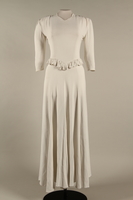
Wedding dress with ruffle made for the marriage of 2 German Jewish DP camp aid workers
Object
White, full skirted gown worn by Alice Redlich, 28, at her wedding to Hans Finke, 28, at the Bergen-Belsen displaced persons camp on June 20, 1948. The dress was made by her sister-in-law Ursula, a seamstress. She made the dress in Berlin and brought it to Bergen Belsen during a visit to friends in Bavaria. The British Army liberated Bergen-Belsen on April 15, 1945, and it became a DP camp. Hans and Alice were aid workers when they met and married. Alice and her family were German Jews living in Berlin during the rise of the Nazi dictatorship with its aggressive anti-Jewish policies. Alice left for England in 1938 to continue her nurses's training. She volunteered with the Jewish Committee for Relief Abroad and, in September 1946, left for the Bergen-Belsen DP camp in Germany. Her mother, father, and brother were murdered in Auschwitz in 1943. Hans was also from Berlin. In February 1943, Hans was a slave laborer for Siemens when he was hospitalized with appendicitis. On February 29, his parents were deported to Auschwitz. On March 8, the Gestapo raided the hospital and arrested staff and patients. Hans was transported to Monowitz concentration camp, and later sent to Auschwitz, Sachsenhausen, Flossenberg, and Bergen-Belsen. His parents were murdered in Auschwitz, but his sister Ursula survived in hiding. On August 29, 1949, John and Alice, then pregnant with their first child, immigrated to the United States.
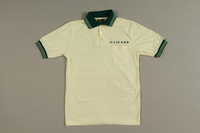
Yellow sport short listing concentration camps where the owner was imprisoned
Object
Yellow polo shirt that belonged to Hans Finke, a concentration camp survivor who became an aid worker after the war. The shirt was made for a survivor's reunion Hans attended after the war. Hans, his parents and his sister Ursula lived in Berlin during the rise of the Nazi dictatorship in 1933 with its aggressive anti-Jewish policies. Jews were forced out of their jobs and their businesses were confiscated. In February 1943, Hans, 23, an electrician by trade, was a forced laborer for Siemens when he was hospitalized with appendicitis. On February 29, his parents were rounded up and deported to Auschwitz. On March 8, the Gestapo raided the hospital and arrested staff and patients. Hans was transported to Monowitz concentration camp, and later sent to Auschwitz, Sachsenhausen, Flossenberg, and Bergen-Belsen concentration camps. Hans was in Bergen-Belsen when it was liberated by the British Army. His parents were murdered in Auschwitz, but his sister Ursula survived in hiding. Bergen-Belsen became a displaced persons camp and Hans began working for the British and then various aid groups. He met Alice Redlich, who had left Berlin for England in 1938 to continue her nurses's training. She volunteered with the Jewish Committee for Relief Abroad and, in September 1946, left for the Bergen-Belsen DP camp in Germany. Her family was murdered in Auschwitz concentration camp in 1943. Alice and Hans married on June 20, 1948, in the camp. The couple, with Alice pregnant with their first child, immigrated to the United States on August 29, 1949.
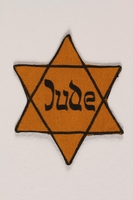
Star of David patch worn by a German Jewish concentration camp inmate
Object
Judenstern badge worn by Hans Finke, a concentration camp survivor who became an aid worker after the war. Hans, his parents and his sister Ursula lived in Berlin during the rise of the Nazi dictatorship in 1933 with its aggressive anti-Jewish policies. Jews were forced out of their jobs and their businesses were confiscated. In February 1943, Hans, 23, an electrician by trade, was a forced laborer for Siemens when he was hospitalized with appendicitis. On February 29, his parents were rounded up and deported to Auschwitz. On March 8, the Gestapo raided the hospital and arrested staff and patients. Hans was transported to Monowitz concentration camp, and later sent to Auschwitz, Sachsenhausen, Flossenberg, and Bergen-Belsen concentration camps. Hans was in Bergen-Belsen when it was liberated by the British Army. His parents were murdered in Auschwitz, but his sister Ursula survived in hiding. Bergen-Belsen became a displaced persons camp and Hans began working for the British and then various aid groups. He met Alice Redlich, who had left Berlin for England in 1938 to continue her nurses's training. She volunteered with the Jewish Committee for Relief Abroad and, in September 1946, left for the Bergen-Belsen DP camp in Germany. Her family was murdered in Auschwitz concentration camp in 1943. Alice and Hans married on June 20, 1948, in the camp. The couple, with Alice pregnant with their first child, immigrated to the United States on August 29, 1949.
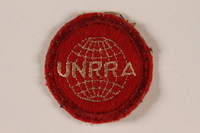
UNRRA embroidered patch worn by a survivor and DP camp relief worker
Object
Circular, red, UNRRA (United Nations Relief and Rehabilitation Administration) patch worn by Hans Finke (later John Fink) when he worked for the organization as a store manager in a refugee center in Germany from 1946-47. Hans was a prisoner at Bergen-Belsen when it was liberated by the British Army on April 15, 1945. An electrician by trade, he began working for the British and then various aid groups after it became a displaced persons camp. Hans, his parents, and his sister, Ursula, lived in Berlin during the rise of the Nazi dictatorship in 1933 with its aggressive anti-Jewish policies. Jews were required to wear the yellow stars beginning in September 1941. In February 1943, Hans, 23, was a forced laborer for Siemens when he was hospitalized with appendicitis. On February 29, his parents were rounded up and deported to Auschwitz. On March 8, the Gestapo raided the hospital and arrested staff and patients. Hans was transported to Buna-Monowitz concentration camp, and later sent to Auschwitz, Sachsenhausen, Flossenberg, and Bergen-Belsen concentration camps. Hans was in Bergen-Belsen when it was liberated in April 1945. His parents were murdered in Auschwitz, but his sister Ursula survived in hiding. Bergen-Belsen became a displaced persons camp and Hans began working for various aid groups. He met Alice Redlich, who had left Berlin for England in 1938 to continue her nurses's training. She volunteered with the Jewish Committee for Relief Abroad and, in September 1946, left for the Bergen-Belsen DP camp in Germany. Her family was murdered in Auschwitz in 1943. Alice and Hans married on June 20, 1948, in the DP camp. The couple, with Alice pregnant with their first child, immigrated to the United States on August 29, 1949.
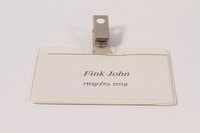
Clip-on name tag worn postwar by a former concentration camp inmate
Object
Name tag in clip on holder worn after the war by Hans Finke, a concentration camp survivor who became an aid worker after the war. He was at Bergen-Belsen when it was liberated by the British Army on April 15, 1945. An electrician by trade, he began working for the British and then various aid groups after it became a displaced persons camp.Hans, his parents and his sister Ursula lived in Berlin during the rise of the Nazi dictatorship in 1933 with its aggressive anti-Jewish policies. In February 1943, Hans, 23, was a forced laborer for Siemens when he was hospitalized with appendicitis. On February 29, his parents were rounded up and deported to Auschwitz. On March 8, the Gestapo raided the hospital and arrested staff and patients. Hans was transported to Buna-Monowitz concentration camp, and later sent to Auschwitz, Sachsenhausen, Flossenberg, and Bergen-Belsen concentration camps. Hans was in Bergen-Belsen when it was liberated.in April 1945. His parents were murdered in Auschwitz, but his sister Ursula survived in hiding. Bergen-Belsen became a displaced persons camp and Hans began working for the British and then various aid groups. He met Alice Redlich, who had left Berlin for England in 1938 to continue her nurses's training. She volunteered with the Jewish Committee for Relief Abroad and, in September 1946, left for the Bergen-Belsen DP camp in Germany. Her family was murdered in Auschwitz concentration camp in 1943. Alice and Hans married on June 20, 1948, in the DP camp. The couple, with Alice pregnant with their first child, immigrated to the United States on August 29, 1949.
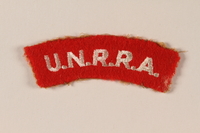
Red UNRRA patch worn by a former concentration camp inmate and DP aid worker
Object
UNRRA (United Nations Relief and Rehabilitation Administration) arch patch worn by aid worker Hans Finke when he worked for UNRRA in 1946-47 as a store manager in a refugee center in postwar Germany. Hans was at Bergen-Belsen when it was liberated by the British Army on April 15, 1945. An electrician by trade, he began working for the British and then various aid groups after it became a displaced persons camp. Hans, his parents and his sister Ursula lived in Berlin during the rise of the Nazi dictatorship in 1933 with its aggressive anti-Jewish policies. Jews were required to wear the yellow stars in September 1941. In February 1943, Hans, 23, was a forced laborer for Siemens when he was hospitalized with appendicitis. On February 29, his parents were rounded up and deported to Auschwitz. On March 8, the Gestapo raided the hospital and arrested staff and patients. Hans was transported to Buna-Monowitz concentration camp, and later sent to Auschwitz, Sachsenhausen, Flossenberg, and Bergen-Belsen concentration camps. Hans was in Bergen-Belsen when it was liberated.in April 1945. His parents were murdered in Auschwitz, but his sister Ursula survived in hiding. Bergen-Belsen became a displaced persons camp and Hans began working for the British and then various aid groups. He met Alice Redlich, who had left Berlin for England in 1938 to continue her nurses's training. She volunteered with the Jewish Committee for Relief Abroad and, in September 1946, left for the Bergen-Belsen DP camp in Germany. Her family was murdered in Auschwitz concentration camp in 1943. Alice and Hans married on June 20, 1948, in the DP camp. The couple, with Alice pregnant with their first child, immigrated to the United States on August 29, 1949.
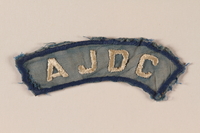
AJDC bar patch worn by a former concentration camp inmate and refugee aid worker
Object
American Jewish Joint Distribution Committee (AJDC) badge worn by aid worker Hans Finke when he worked for the relief organization after the end of World War II. He was at Bergen-Belsen when it was liberated by the British Army on April 15, 1945. An electrician by trade, he began working for the British and then various aid groups after it became a displaced persons camp. Hans, his parents and his sister Ursula lived in Berlin during the rise of the Nazi dictatorship in 1933 with its aggressive anti-Jewish policies. In February 1943, Hans, 23, was a forced laborer for Siemens when he was hospitalized with appendicitis. On February 29, his parents were rounded up and deported to Auschwitz. On March 8, the Gestapo raided the hospital and arrested staff and patients. Hans was transported to Buna-Monowitz concentration camp, and later sent to Auschwitz, Sachsenhausen, Flossenberg, and Bergen-Belsen concentration camps. Hans was in Bergen-Belsen when it was liberated.in April 1945. His parents were murdered in Auschwitz, but his sister Ursula survived in hiding. Bergen-Belsen became a displaced persons camp and Hans began working for the British and then various aid groups. He met Alice Redlich, who had left Berlin for England in 1938 to continue her nurses's training. She volunteered with the Jewish Committee for Relief Abroad and, in September 1946, left for the Bergen-Belsen DP camp in Germany. Her family was murdered in Auschwitz concentration camp in 1943. Alice and Hans married on June 20, 1948, in the DP camp. The couple, with Alice pregnant with their first child, immigrated to the United States on August 29, 1949.
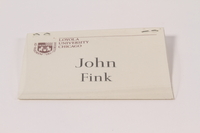
Name tag worn postwar by a former concentration camp inmate
Object
Name tag worn postwar by Hans Finke, a concentration camp inmate who became an aid worker after the war. He was at Bergen-Belsen when it was liberated by the British Army on April 15, 1945. An electrician by trade, he began working for the British and then various aid groups after it became a displaced persons camp. Hans, his parents and his sister Ursula lived in Berlin during the rise of the Nazi dictatorship in 1933 with its aggressive anti-Jewish policies. In February 1943, Hans, 23, was a forced laborer for Siemens when he was hospitalized with appendicitis. On February 29, his parents were rounded up and deported to Auschwitz. On March 8, the Gestapo raided the hospital and arrested staff and patients. Hans was transported to Buna-Monowitz concentration camp, and later sent to Auschwitz, Sachsenhausen, Flossenberg, and Bergen-Belsen concentration camps. Hans was in Bergen-Belsen when it was liberated.in April 1945. His parents were murdered in Auschwitz, but his sister Ursula survived in hiding. Bergen-Belsen became a displaced persons camp and Hans began working for the British and then various aid groups. He met Alice Redlich, who had left Berlin for England in 1938 to continue her nurses's training. She volunteered with the Jewish Committee for Relief Abroad and, in September 1946, left for the Bergen-Belsen DP camp in Germany. Her family was murdered in Auschwitz concentration camp in 1943. Alice and Hans married on June 20, 1948, in the DP camp. The couple, with Alice pregnant with their first child, immigrated to the United States on August 29, 1949.
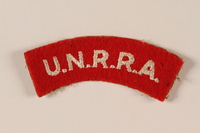
Embroidered, red UNRRA worn by a former concentration camp inmate and DP relief worker
Object
UNRRA (United Nations Relief and Rehabilitation Administration) bar patch worn by aid worker Hans Finke when he worked for the United Nations as a store manager in postwar Germany. He was at Bergen-Belsen when it was liberated by the British Army on April 15, 1945. An electrician by trade, he began working for the British and then various aid groups after it became a displaced persons camp. Hans, his parents and his sister Ursula lived in Berlin during the rise of the Nazi dictatorship in 1933 with its aggressive anti-Jewish policies. In February 1943, Hans, 23, was a forced laborer for Siemens when he was hospitalized with appendicitis. On February 29, his parents were rounded up and deported to Auschwitz. On March 8, the Gestapo raided the hospital and arrested staff and patients. Hans was transported to Buna-Monowitz concentration camp, and later sent to Auschwitz, Sachsenhausen, Flossenberg, and Bergen-Belsen concentration camps. Hans was in Bergen-Belsen when it was liberated.in April 1945. His parents were murdered in Auschwitz, but his sister Ursula survived in hiding. Bergen-Belsen became a displaced persons camp and Hans began working for the British and then various aid groups. He met Alice Redlich, who had left Berlin for England in 1938 to continue her nurses's training. She volunteered with the Jewish Committee for Relief Abroad and, in September 1946, left for the Bergen-Belsen DP camp in Germany. Her family was murdered in Auschwitz concentration camp in 1943. Alice and Hans married on June 20, 1948, in the DP camp. The couple, with Alice pregnant with their first child, immigrated to the United States on August 29, 1949.
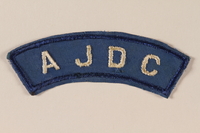
Blue AJDC patch worn by a former concentration camp inmate and refugee aid worker
Object
American Jewish Joint Distribution Committee (AJDC) patch worn by aid worker Hans Finke when he worked for relief organization after the end of World War II. He was at Bergen-Belsen when it was liberated by the British Army on April 15, 1945. An electrician by trade, he began working for the British and then various aid groups after it became a displaced persons camp. Hans, his parents and his sister Ursula lived in Berlin during the rise of the Nazi dictatorship in 1933 with its aggressive anti-Jewish policies. In February 1943, Hans, 23, was a forced laborer for Siemens when he was hospitalized with appendicitis. On February 29, his parents were rounded up and deported to Auschwitz. On March 8, the Gestapo raided the hospital and arrested staff and patients. Hans was transported to Buna-Monowitz concentration camp, and later sent to Auschwitz, Sachsenhausen, Flossenberg, and Bergen-Belsen concentration camps. Hans was in Bergen-Belsen when it was liberated.in April 1945. His parents were murdered in Auschwitz, but his sister Ursula survived in hiding. Bergen-Belsen became a displaced persons camp and Hans began working for the British and then various aid groups. He met Alice Redlich, who had left Berlin for England in 1938 to continue her nurses's training. She volunteered with the Jewish Committee for Relief Abroad and, in September 1946, left for the Bergen-Belsen DP camp in Germany. Her family was murdered in Auschwitz concentration camp in 1943. Alice and Hans married on June 20, 1948, in the DP camp. The couple, with Alice pregnant with their first child, immigrated to the United States on August 29, 1949.
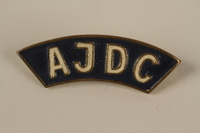
Blue AJDC pin worn by a former concentration camp inmate and refugee aid worker
Object
American Jewish Joint Distribution Committee (AJDC) blue enamel pin worn by aid worker Hans Finke when he worked for relief organization after the end of World War II. He was at Bergen-Belsen when it was liberated by the British Army on April 15, 1945. An electrician by trade, he began working for the British and then various aid groups after it became a displaced persons camp. Hans, his parents and his sister Ursula lived in Berlin during the rise of the Nazi dictatorship in 1933 with its aggressive anti-Jewish policies. In February 1943, Hans, 23, was a forced laborer for Siemens when he was hospitalized with appendicitis. On February 29, his parents were rounded up and deported to Auschwitz. On March 8, the Gestapo raided the hospital and arrested staff and patients. Hans was transported to Buna-Monowitz concentration camp, and later sent to Auschwitz, Sachsenhausen, Flossenberg, and Bergen-Belsen concentration camps. Hans was in Bergen-Belsen when it was liberated.in April 1945. His parents were murdered in Auschwitz, but his sister Ursula survived in hiding. Bergen-Belsen became a displaced persons camp and Hans began working for the British and then various aid groups. He met Alice Redlich, who had left Berlin for England in 1938 to continue her nurses's training. She volunteered with the Jewish Committee for Relief Abroad and, in September 1946, left for the Bergen-Belsen DP camp in Germany. Her family was murdered in Auschwitz concentration camp in 1943. Alice and Hans married on June 20, 1948, in the DP camp. The couple, with Alice pregnant with their first child, immigrated to the United States on August 29, 1949.
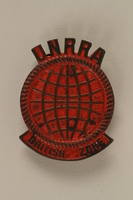
Globe-shaped UNRRA pin worn by a former concentration camp inmate and refugee aid worker
Object
UNRRA (United Nations Relief and Rehabilitation Administration) globe shaped pin worn by aid worker Hans Finke when he worked for the United Nations as a store manager in postwar Germany. He was at Bergen-Belsen when it was liberated by the British Army on April 15, 1945. An electrician by trade, he began working for the British and then various aid groups after it became a displaced persons camp. Hans, his parents and his sister Ursula lived in Berlin during the rise of the Nazi dictatorship in 1933 with its aggressive anti-Jewish policies. In February 1943, Hans, 23, was a forced laborer for Siemens when he was hospitalized with appendicitis. On February 29, his parents were rounded up and deported to Auschwitz. On March 8, the Gestapo raided the hospital and arrested staff and patients. Hans was transported to Buna-Monowitz concentration camp, and later sent to Auschwitz, Sachsenhausen, Flossenberg, and Bergen-Belsen concentration camps. Hans was in Bergen-Belsen when it was liberated.in April 1945. His parents were murdered in Auschwitz, but his sister Ursula survived in hiding. Bergen-Belsen became a displaced persons camp and Hans began working for the British and then various aid groups. He met Alice Redlich, who had left Berlin for England in 1938 to continue her nurses's training. She volunteered with the Jewish Committee for Relief Abroad and, in September 1946, left for the Bergen-Belsen DP camp in Germany. Her family was murdered in Auschwitz concentration camp in 1943. Alice and Hans married on June 20, 1948, in the DP camp. The couple, with Alice pregnant with their first child, immigrated to the United States on August 29, 1949.
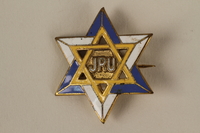
Jewish Relief Unit Star of David pin worn by a German Jewish nurse working in a DP camp
Object
Jewish Relief Unit pin worn by Alice Redlich while she served as a nurse at the displaced persons camp established in the former concentration camp in Germany after the war. The British army liberated Bergen-Belsen on April 15, 1945, and it then became a DP camp. Alice and her family were German Jews living in Berlin during the rise of the Nazi dictatorship. In 1938, 18 year old Alice left for England to continue her nurse's training. She volunteered with the Jewish Committee for Relief Abroad and, in September 1946, she left for the Bergen-Belsen displaced persons camp to care for children and young women. Her mother, father, brother, and grandmother were all murdered in Auschwitz. She met and married Hans Finke, a fellow German Jewish relief worker, at the camp in 1948. Hans had been a prisoner of Monowitz, Auschwitz, Sachsenhausen, Flossenberg, and Bergen-Belsen concentration camps. His parents were murdered in Auschwitz and his sister survived in hiding. Hans was at Bergen-Belsen when it was liberated by the British Army on April 15, 1945. An electrician by trade, he began working for the British and then various aid groups after it became a displaced persons camp.
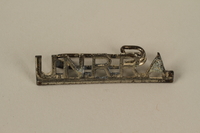
Silver UNRRA pin worn by a former concentration camp inmate and refugee aid worker
Object
UNRRA (United Nations Relief and Rehabilitation Administration) logo shaped pin worn by aid worker Hans Finke when he worked for the United Nations as a store manager in postwar Germany. He was at Bergen-Belsen when it was liberated by the British Army on April 15, 1945. An electrician by trade, he began working for the British and then various aid groups after it became a displaced persons camp. Hans, his parents and his sister Ursula lived in Berlin during the rise of the Nazi dictatorship in 1933 with its aggressive anti-Jewish policies. In February 1943, Hans, 23, was a forced laborer for Siemens when he was hospitalized with appendicitis. On February 29, his parents were rounded up and deported to Auschwitz. On March 8, the Gestapo raided the hospital and arrested staff and patients. Hans was transported to Buna-Monowitz concentration camp, and later sent to Auschwitz, Sachsenhausen, Flossenberg, and Bergen-Belsen concentration camps. Hans was in Bergen-Belsen when it was liberated.in April 1945. His parents were murdered in Auschwitz, but his sister Ursula survived in hiding. Bergen-Belsen became a displaced persons camp and Hans began working for the British and then various aid groups. He met Alice Redlich, who had left Berlin for England in 1938 to continue her nurses's training. She volunteered with the Jewish Committee for Relief Abroad and, in September 1946, left for the Bergen-Belsen DP camp in Germany. Her family was murdered in Auschwitz concentration camp in 1943. Alice and Hans married on June 20, 1948, in the DP camp. The couple, with Alice pregnant with their first child, immigrated to the United States on August 29, 1949.
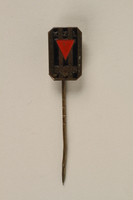
Commemorative pin worn postwar by a former concentration camp inmate and refugee aid worker
Object
Commemorative stickpin worn postwar by Hans Finke, a concentration camp inmate who became an aid worker after the war. It has an inverted red triangle on a blue and gray striped field representing concentration camp uniforms. Hans was at Bergen-Belsen when it was liberated by the British Army on April 15, 1945. An electrician by trade, he began working for the British and then various aid groups after it became a displaced persons camp. Hans, his parents and his sister Ursula lived in Berlin during the rise of the Nazi dictatorship in 1933 with its aggressive anti-Jewish policies. In February 1943, Hans, 23, was a forced laborer for Siemens when he was hospitalized with appendicitis. On February 29, his parents were rounded up and deported to Auschwitz. On March 8, the Gestapo raided the hospital and arrested staff and patients. Hans was transported to Buna-Monowitz concentration camp, and later sent to Auschwitz, Sachsenhausen, Flossenberg, and Bergen-Belsen concentration camps. Hans was in Bergen-Belsen when it was liberated.in April 1945. His parents were murdered in Auschwitz, but his sister Ursula survived in hiding. Bergen-Belsen became a displaced persons camp and Hans began working for the British and then various aid groups. He met Alice Redlich, who had left Berlin for England in 1938 to continue her nurses's training. She volunteered with the Jewish Committee for Relief Abroad and, in September 1946, left for the Bergen-Belsen DP camp in Germany. Her family was murdered in Auschwitz concentration camp in 1943. Alice and Hans married on June 20, 1948, in the DP camp. The couple, with Alice pregnant with their first child, immigrated to the United States on August 29, 1949.
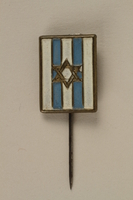
Star of David stickpin worn postwar by a former concentration camp inmate and refugee aid worker
Object
Commemorative stickpin worn postwar by Hans Finke, a concentration camp inmate who became an aid worker after the war. It has a Star of David on a blue and white striped field representing the flag of Israel. Hans was at Bergen-Belsen when it was liberated by the British Army on April 15, 1945. An electrician by trade, he began working for the British and then various aid groups after it became a displaced persons camp. Hans, his parents and his sister Ursula lived in Berlin during the rise of the Nazi dictatorship in 1933 with its aggressive anti-Jewish policies. In February 1943, Hans, 23, was a forced laborer for Siemens when he was hospitalized with appendicitis. On February 29, his parents were rounded up and deported to Auschwitz. On March 8, the Gestapo raided the hospital and arrested staff and patients. Hans was transported to Buna-Monowitz concentration camp, and later sent to Auschwitz, Sachsenhausen, Flossenberg, and Bergen-Belsen concentration camps. Hans was in Bergen-Belsen when it was liberated.in April 1945. His parents were murdered in Auschwitz, but his sister Ursula survived in hiding. Bergen-Belsen became a displaced persons camp and Hans began working for the British and then various aid groups. He met Alice Redlich, who had left Berlin for England in 1938 to continue her nurses's training. She volunteered with the Jewish Committee for Relief Abroad and, in September 1946, left for the Bergen-Belsen DP camp in Germany. Her family was murdered in Auschwitz concentration camp in 1943. Alice and Hans married on June 20, 1948, in the DP camp. The couple, with Alice pregnant with their first child, immigrated to the United States on August 29, 1949.
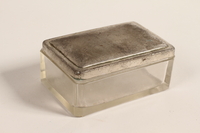
Glass and silver keepsake box used by a German Jewish refugee nurse and postwar aid worker
Object
Small glass box with a silver lid box owned by Alice Redlich while she served as a nurse at the displaced persons camp established in the former concentration camp in Germany after the war. The British army liberated Bergen-Belsen on April 15, 1945, and it then became a DP camp. Alice and her family were German Jews living in Berlin during the rise of the Nazi dictatorship. In 1938, 18 year old Alice left for England to continue her nurse's training. She volunteered with the Jewish Committee for Relief Abroad and, in September 1946, she left for the Bergen-Belsen displaced persons camp to care for children and young women. Her mother, father, brother, and grandmother were all murdered in Auschwitz. She met and married Hans Finke, a fellow German Jewish relief worker, at the camp in 1948. Hans had been a prisoner of Monowitz, Auschwitz, Sachsenhausen, Flossenberg, and Bergen-Belsen concentration camps. His parents were murdered in Auschwitz and his sister survived in hiding.
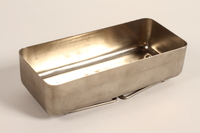
Medical field sterilizer kit used by a German Jewish refugee nurse and postwar aid worker
Object
Medical field sterilizer kit with container and strainer tray, ethanol burner, instruments, a boxed set of 2 bottles of Lobelin used by Alice Redlich while she served as a nurse at the Bergen Belsen displaced persons camp established in the former concentration camp in Germany after the war. The British army liberated Bergen-Belsen on April 15, 1945, and it then became a DP camp. Alice volunteered with the Jewish Committee for Relief Abroad and, in September 1946, she left for Bergen-Belsen DP camp to care for children and young women. Before the war, Alice lived with her parents in Berlin, Germany, through the rise of the Nazi dictatorship with its increasingly harsh anti-Jewish policies. In 1938, 18 year old Alice left for England to continue her nurse's training. Her mother, father, brother, and grandmother were all murdered in Auschwitz. She met and married Hans Finke, a fellow German Jewish relief worker, at the DP camp in 1948. Hans had been a prisoner of Monowitz, Auschwitz, Sachsenhausen, Flossenberg, and Bergen-Belsen concentration camps. His parents were murdered in Auschwitz and his sister survived in hiding. Hans was at Bergen-Belsen when it was liberated by the British Army on April 15, 1945. An electrician by trade, he began working for the British and then various aid groups after it became a displaced persons camp.
Oral history interview with John Fink
Oral History
Alice and John Fink papers
Document
The Alice and John Fink papers include biographical materials, photographs, printed materials, and subject files documenting Alice and John, their families in Germany, Alice’s nursing education and work in England, John’s survival in concentration camps during the Holocaust, and the couple’s work at the Bergen-Belsen displaced persons camp after the war. Biographical materials include identification, education, employment, displaced persons, and restitution papers documenting John and Alice Fink as well as their ketubah. John Fink materials include his Bar Mitzvah certificate, school report cards, apprentice certificate, identification and work cards, correspondence, restitution claims, and a personal narrative documenting his childhood in Berlin, forced labor in the Siemens factory during the Holocaust, and post-war work for the British Red Cross and United Nations Relief and Rehabilitation Administration. Alice Fink materials include a school certificate, British passport, identification card, employment records, and registered nurse and midwife certificates documenting her childhood in Berlin, training as a nurse, prewar and wartime work in England, and postwar work at the Bergen-Belsen displaced persons camp. Photographic materials include two large and two small photo albums and many loose photographs depicting Alice and John Fink, their families in prewar Berlin, and their postwar work at the Bergen-Belsen displaced persons camp. This series includes copy prints of liberation photographs of the Bergen-Belsen concentration camp. Color photographs depict the Blankenese children’s home after it became the Elsa Brändström Haus. Printed materials include postwar issues of Jüdisches Gemeindeblatt für die Nord-Rheinprovinz und Westfalen, Our Voice: Central Jewish Committee, and Jüdisches Gemeindeblatt für die Britische Zone; photocopied clippings about the Holocaust; a 1983 issue of AJR Information; and 1991-1992 issues of ORT-Deutschland Magazin. Subject files include clippings, correspondence, notes, printed materials, postcards, and testimony. The files document the Bergen-Belsen concentration camp and its liberation, Gyuszi Szabo (a Hungarian Jew living in Rotterdam at the outbreak of World War II), Holocaust commemoration, a Holocaust art exhibition at Indiana University Bloomington, the Landwerk Neuendorf hachshara, the United States Holocaust Memorial Museum, and the Blankenese children’s home (Elsa Brandstrom Haus).
Star of David patch worn by a German Jewish concentration camp inmate
Object
Judenstern badge worn by Hans Finke, a concentration camp survivor who became an aid worker after the war. Hans, his parents and his sister Ursula lived in Berlin during the rise of the Nazi dictatorship in 1933 with its aggressive anti-Jewish policies. Jews were forced out of their jobs and their businesses were confiscated. In February 1943, Hans, 23, an electrician by trade, was a forced laborer for Siemens when he was hospitalized with appendicitis. On February 29, his parents were rounded up and deported to Auschwitz. On March 8, the Gestapo raided the hospital and arrested staff and patients. Hans was transported to Monowitz concentration camp, and later sent to Auschwitz, Sachsenhausen, Flossenberg, and Bergen-Belsen concentration camps. Hans was in Bergen-Belsen when it was liberated by the British Army. His parents were murdered in Auschwitz, but his sister Ursula survived in hiding. Bergen-Belsen became a displaced persons camp and Hans began working for the British and then various aid groups. He met Alice Redlich, who had left Berlin for England in 1938 to continue her nurses's training. She volunteered with the Jewish Committee for Relief Abroad and, in September 1946, left for the Bergen-Belsen DP camp in Germany. Her family was murdered in Auschwitz concentration camp in 1943. Alice and Hans married on June 20, 1948, in the camp. The couple, with Alice pregnant with their first child, immigrated to the United States on August 29, 1949.
Pouch and medical instruments used by a German Jewish refugee nurse and postwar aid worker
Object
Medical kit and contents used by Alice Redlich while she served as a nurse at the displaced persons camp established in the former concentration camp in Germany after the war. The British Army liberated Bergen-Belsen on April 15, 1945, and it then became a DP camp. Alice and her family were German Jews living in Berlin during the rise of the Nazi dictatorship. In 1938, 18 year old Alice left for England to continue her nurse's training. She volunteered with the Jewish Committee for Relief Abroad and, in September 1946, she left for the Bergen-Belsen displaced persons camp to care for children and young women. Her mother, father, brother, and grandmother were all murdered in Auschwitz. She met and married Hans Finke, a fellow German Jewish relief worker, at the camp in 1948. Hans had been a prisoner of Monowitz, Auschwitz, Sachsenhausen, Flossenberg, and Bergen-Belsen concentration camps. His parents were murdered in Auschwitz and his sister survived in hiding.
Needle packet used by a German Jewish refugee nurse and aid worker
Object
Needle packet used by Alice Redlich while she served as a nurse at the displaced persons camp established in the former concentration camp in Germany after the war. The British Army liberated Bergen-Belsen on April 15, 1945, and it then became a DP camp. Alice and her family were German Jews living in Berlin during the rise of the Nazi dictatorship. In 1938, 18 year old Alice left for England to continue her nurse's training. She volunteered with the Jewish Committee for Relief Abroad and, in September 1946, she left for the Bergen-Belsen displaced persons camp to care for children and young women. Her mother, father, brother, and grandmother were all murdered in Auschwitz. She met and married Hans Finke, a fellow German Jewish relief worker, at the camp in 1948. Hans had been a prisoner of Monowitz, Auschwitz, Sachsenhausen, Flossenberg, and Bergen-Belsen concentration camps. His parents were murdered in Auschwitz and his sister survived in hiding.
Box and needles used by a German Jewish refugee nurse and aid worker
Object
Box and needles used by Alice Redlich while she served as a nurse at the displaced persons camp established in the former concentration camp in Germany after the war. The British Army liberated Bergen-Belsen on April 15, 1945, and it then became a DP camp. Alice and her family were German Jews living in Berlin during the rise of the Nazi dictatorship. In 1938, 18 year old Alice left for England to continue her nurse's training. She volunteered with the Jewish Committee for Relief Abroad and, in September 1946, she left for the Bergen-Belsen displaced persons camp to care for children and young women. Her mother, father, brother, and grandmother were all murdered in Auschwitz. She met and married Hans Finke, a fellow German Jewish relief worker, at the camp in 1948. Hans had been a prisoner of Monowitz, Auschwitz, Sachsenhausen, Flossenberg, and Bergen-Belsen concentration camps. His parents were murdered in Auschwitz and his sister survived in hiding.
Box and needles used by a German Jewish refugee nurse and aid worker
Object
Box and needles used by Alice Redlich while she served as a nurse at the displaced persons camp established in the former concentration camp in Germany after the war. The British Army liberated Bergen-Belsen on April 15, 1945, and it then became a DP camp. Alice and her family were German Jews living in Berlin during the rise of the Nazi dictatorship. In 1938, 18 year old Alice left for England to continue her nurse's training. She volunteered with the Jewish Committee for Relief Abroad and, in September 1946, she left for the Bergen-Belsen displaced persons camp to care for children and young women. Her mother, father, brother, and grandmother were all murdered in Auschwitz. She met and married Hans Finke, a fellow German Jewish relief worker, at the camp in 1948. Hans had been a prisoner of Monowitz, Auschwitz, Sachsenhausen, Flossenberg, and Bergen-Belsen concentration camps. His parents were murdered in Auschwitz and his sister survived in hiding.
Bag and supplies used by a German Jewish refugee nurse and aid worker
Object
Bag and contents used by Alice Redlich while she served as a nurse at the displaced persons camp established in the former concentration camp in Germany after the war. The British Army liberated Bergen-Belsen on April 15, 1945, and it then became a DP camp. Alice and her family were German Jews living in Berlin during the rise of the Nazi dictatorship. In 1938, 18 year old Alice left for England to continue her nurse's training. She volunteered with the Jewish Committee for Relief Abroad and, in September 1946, she left for the Bergen-Belsen displaced persons camp to care for children and young women. Her mother, father, brother, and grandmother were all murdered in Auschwitz. She met and married Hans Finke, a fellow German Jewish relief worker, at the camp in 1948. Hans had been a prisoner of Monowitz, Auschwitz, Sachsenhausen, Flossenberg, and Bergen-Belsen concentration camps. His parents were murdered in Auschwitz and his sister survived in hiding.
Container used by a German Jewish refugee nurse and aid worker
Object
Container used by Alice Redlich while she served as a nurse at the displaced persons camp established in the former concentration camp in Germany after the war. The British Army liberated Bergen-Belsen on April 15, 1945, and it then became a DP camp. Alice and her family were German Jews living in Berlin during the rise of the Nazi dictatorship. In 1938, 18 year old Alice left for England to continue her nurse's training. She volunteered with the Jewish Committee for Relief Abroad and, in September 1946, she left for the Bergen-Belsen displaced persons camp to care for children and young women. Her mother, father, brother, and grandmother were all murdered in Auschwitz. She met and married Hans Finke, a fellow German Jewish relief worker, at the camp in 1948. Hans had been a prisoner of Monowitz, Auschwitz, Sachsenhausen, Flossenberg, and Bergen-Belsen concentration camps. His parents were murdered in Auschwitz and his sister survived in hiding.
Trunk used by a German Jewish refugee nurse and aid worker
Object
Wooden trunk used by John and Alice Redlich Fink for travel to the US. Alice was a nurse at the displaced persons camp established in the former Bergen Belsen concentration camp in Germany after the war. Alice left Nazi Germany in 1938 for England to continue her nurse's training. She volunteered with the Jewish Committee for Relief Abroad and, in September 1946, left for the Bergen-Belsen dp camp to care for children and young women. Her mother, father, brother, and grandmother were all murdered in Auschwitz. She met and married Hans Finke, a fellow German Jewish relief worker, at the camp in 1948. Hans had been a prisoner of Monowitz, Auschwitz, Sachsenhausen, Flossenberg, and Bergen-Belsen concentration camps. His parents were murdered in Auschwitz and his sister survived in hiding. Alice and Hans married on June 20, 1948, in the DP camp. The couple, Alice pregnant with their first child, immigrated to the United States on August 29, 1949.
Trunk used by a former German Jewish concentration camp inmate and aid worker
Object
Wooden trunk used by John and Alice Redlich Fink for travel to the US. Alice was a nurse at the displaced persons camp established in the former Bergen Belsen concentration camp in Germany after the war. Alice left Nazi Germany in 1938 for England to continue her nurse's training. She volunteered with the Jewish Committee for Relief Abroad and, in September 1946, left for the Bergen-Belsen dp camp to care for children and young women. Her mother, father, brother, and grandmother were all murdered in Auschwitz. She met and married Hans Finke, a fellow German Jewish relief worker, at the camp in 1948. Hans had been a prisoner of Monowitz, Auschwitz, Sachsenhausen, Flossenberg, and Bergen-Belsen concentration camps. His parents were murdered in Auschwitz and his sister survived in hiding. Alice and Hans married on June 20, 1948, in the DP camp. The couple, Alice pregnant with their first child, immigrated to the United States on August 29, 1949.



